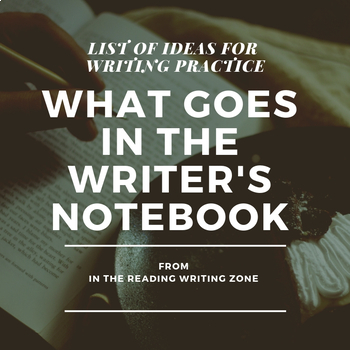In the Reading Writing Zone
76 Followers
Grade Levels
6th - 12th, Adult Education, Homeschool
Subjects
Resource Type
Standards
CCSSCCRA.W.1
CCSSCCRA.W.2
CCSSCCRA.W.3
CCSSCCRA.W.4
CCSSCCRA.W.5
Formats Included
- PDF
In the Reading Writing Zone
76 Followers
Also included in
- Here are 25+ Classroom Forms & Lessons which are essential in any Middle or Secondary Writing Workshop. These lessons are designed to support students in their writing and to help track student growth and identify new writing goals. This is NOT a series of mini lessons on how to deliver creativePrice $25.00Original Price $43.50Save $18.50
Description
Help your students establish a Writer's Notebook. Have your students glue the handout "What goes in the Writer's Notebook" to the inside cover of their new book. Throughout the year ask students to flip back to this list as a tool to guide their writing practice.
"What Goes in the Writer's Notebook" is the first of several lessons in helping students establish and maintain the Writer's Notebook. The notebook is a powerful tool that real writers use everyday in their writing practice. Students will come to see the writing practice as a place to explore and store ideas for now and later, and to enjoy the development of their craft.
Total Pages
Answer Key
N/A
Teaching Duration
45 minutes
Last updated Mar 1st, 2019
Report this resource to TPT
Reported resources will be reviewed by our team. Report this resource to let us know if this resource violates TPT’s content guidelines.
Standards
to see state-specific standards (only available in the US).
CCSSCCRA.W.1
Write arguments to support claims in an analysis of substantive topics or texts, using valid reasoning and relevant and sufficient evidence.
CCSSCCRA.W.2
Write informative/explanatory texts to examine and convey complex ideas and information clearly and accurately through the effective selection, organization, and analysis of content.
CCSSCCRA.W.3
Write narratives to develop real or imagined experiences or events using effective technique, well-chosen details, and well-structured event sequences.
CCSSCCRA.W.4
Produce clear and coherent writing in which the development, organization, and style are appropriate to task, purpose, and audience.
CCSSCCRA.W.5
Develop and strengthen writing as needed by planning, revising, editing, rewriting, or trying a new approach.




